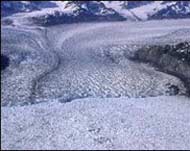Older stories on Resources News
Links to general resource, environmental sites
Links to non-profit environmental/resource groups
Links to environmental/resource news sources
E-mail Resources News
Fast Fading Ice
Ice at the poles - and in glaciers thinning past.
The old saying about something "moving as slow as a glacier" may have to be updated. It seems that global warming is causing many glaciers to move much faster than in the past because they're becoming thinner. The thinning ice is also very evident in both the Arctic and Antarctic.
Climate change trends are most readily observed in the Earth's cold regions, where the sensitivity of ice and snow to temperature changes serves as an early indicator of even relatively small differences. Today's receding and thinning sea ice, mountain glacier mass losses, decreasing snow extent, melting permafrost and rising sea level are all consistent with global warming.
Examination of springtime ice thickness in the Arctic Ocean indicates that the mean ice thickness decreased 1.5 meters - that's almost five feet - between the mid-1980s and early 1990s.
"At low latitudes," says Eric Rignot, a researcher at the Radar Science and Engineering Section of NASA's Jet Propulsion Laboratory, "glacial changes are pronounced, uncontested and solid evidence of climate warming. But what is happening in the polar ice sheets is less clear. My study shows that a number of areas previously believed to be gaining mass in the Antarctic are in fact close to being balanced or even losing mass."
One dramatic example of thinning, retreating ice can be found in Alaska's famed Columbia Glacier. Recent research by New University of Colorado at Boulder indicates the glacier may retreat as much as 10 miles in the next decade, possibly creating a new fjord.
The Columbia Glacier has been under intense study since the late 1970s, when it was determined that a marked increase in its calving rate might pose a risk to shipping lanes. The Columbia is a tidewater glacier, which means its terminus rests on bedrock about a thousand feet below sea level.
In 1977, the glacier was 41.3 miles long and, at its terminus, was moving at 1.3 miles per year. By 1999, the glacier's length had decreased to 33.5 miles, but its speed at the terminus had increased to 5.5 miles per year, or more than 80 feet per day.
"Over the past two decades," says Mark Meier of the Institute for Arctic and Alpine Research, "the glacier retreated just under eight miles. Our models suggest a further retreat of nearly 10 miles over approximately the next decade, meaning that the rate of retreat will essentially double."
The glacier has been thinning at its terminus at an advanced rate over the past twenty years. As the river of ice thins it becomes lighter, and other forces begin to contribute to its flow.
"The interesting thing here is the relationship between rate of retreat and calving speed - or how fast icebergs break off of the glacier at its terminus," said Meier. "The faster the glacier calves, the faster ice will flow to the terminus to replace what is lost. However, the terminus of the glacier is currently in deeper water than it once was and it is thinner on the whole."
Due to these factors - speed from buoyancy created by water underneath, faster calving in the deep water and a thinner terminus - the glacier is calving faster than precipitation can replenish its supply of ice. The net effect is that the entire Columbia Glacier is receding faster and faster, he said.
Meier joked that if his predictions are correct, a new fjord, possibly to be named "Port Columbia" may be formed within the next few decades.
